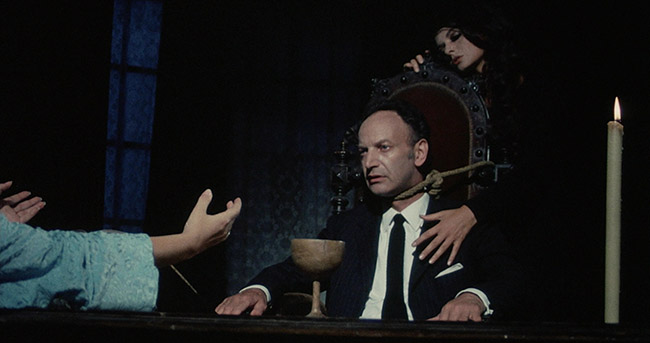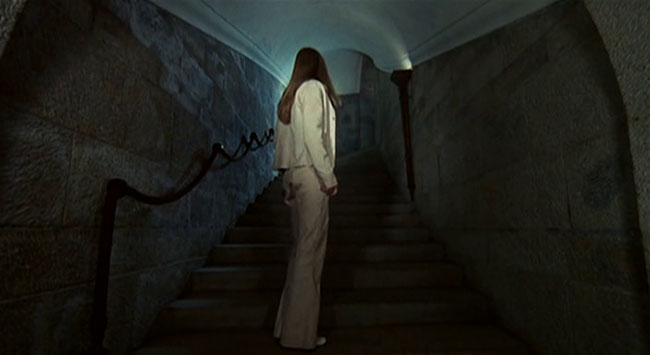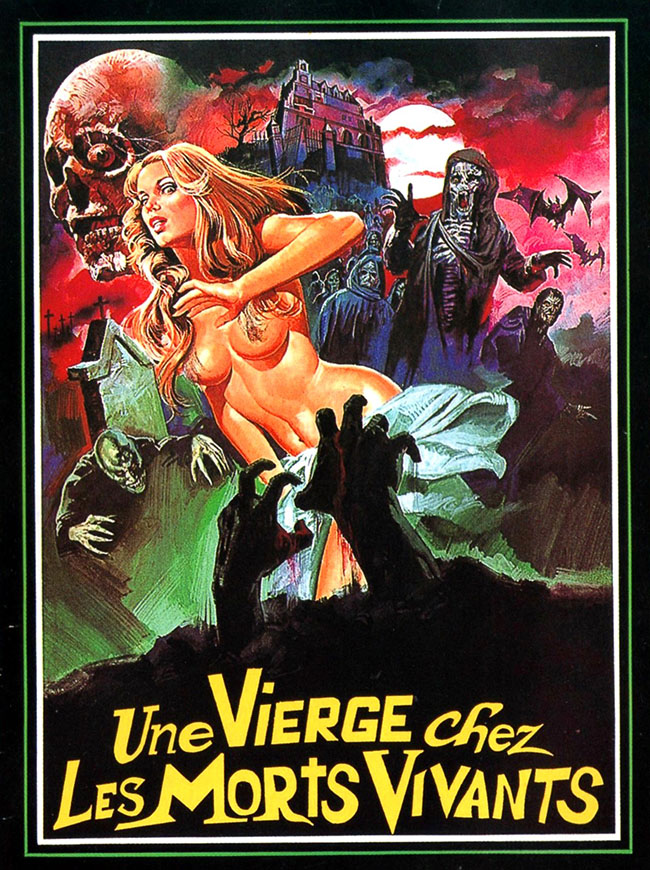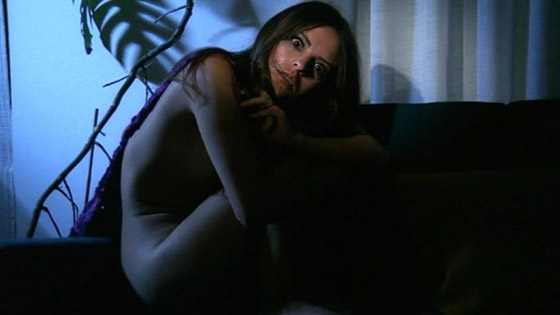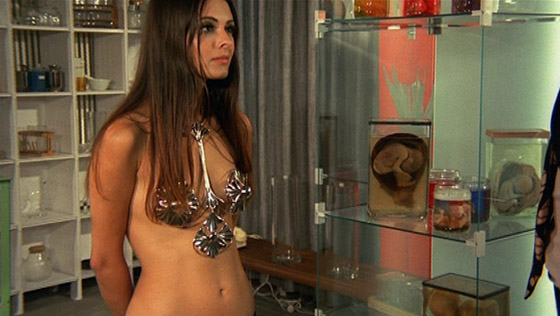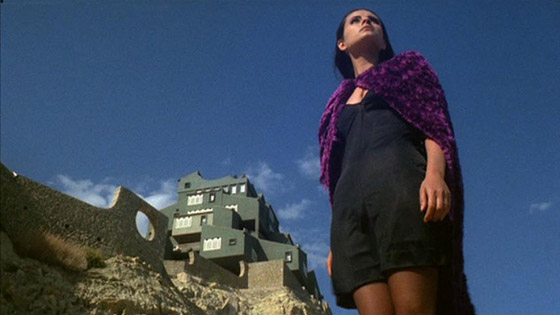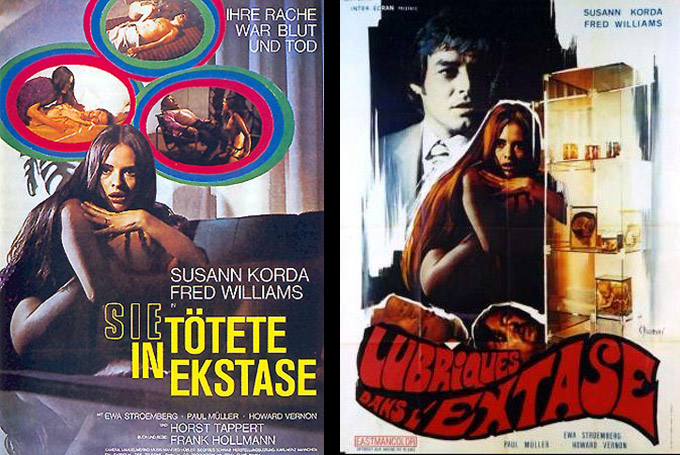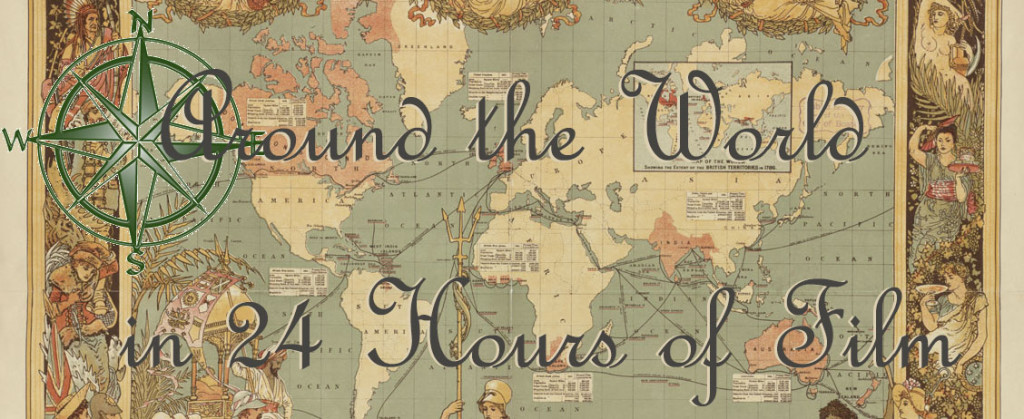
Check for the latest updates on my journey at the bottom of this post.
Here’s the idea for Around the World in 24 Hours of Film. Like Phileas Fogg in Jules Verne’s Around the World in 80 Days, on this day Saturday May the 9th in the year of our Lord 2015, I will be circumnavigating the globe with cinema as my transportation. The origin for this nonsense is an attempt to do a similar thing on Halloween of last year – a 24-hour marathon of horror films – failing a few hours short of the finish line. Seeing as I have to be up in the wee hours of Sunday morning anyway (for personal reasons), now seems the perfect time to make a second attempt: to find motivation to stay up late enough for the aforementioned personal reasons, and to boast that I achieved a complete 24 hour film marathon which no one asked me to do in the first place.
After discussions with my wife, we worked out a series of rules for this game:
1) I must begin, as did Phileas Fogg, in the United Kingdom (he began his journey in London), marking my start time.
2) I must proceed around the world country by country, returning to the U.K. in 24 hours. For each country I cross, I must watch one film. Boarding a jet to skip over countries is considered cheating. Crossing bodies of water must be done in a reasonable fashion to mimic what theoretically might have been a likely route accessible to Mr. Fogg.
3) Each film must be a production or at least a co-production of that country.
4) Each film must be set in that country.
5) I can’t watch two films from the same decade in a row.
6) I am permitted one short film, as an emergency express ticket.
7) The films must be of the sort that I would review on Midnight Only. (Note: Typically I don’t review films more recent than the 80’s.)
8) Random trainspotting rule: I must make note each time I see a train in a film. (My wife’s rule.)
9) Victory can be declared if my last film is from the U.K. (completing the journey), and I am watching it exactly 24 hours after my journey began. (It doesn’t matter if watching that film extends my marathon by an hour or two.)
10) If I can complete the journey much earlier than 24 hours, I should make the most of it by altering my route to take in more countries.
Even a cursory glimpse at a map will reveal potential challenges, particularly with my requirement of not covering a film made in recent decades. I am subject to the availability of films and whether or not a country has a film industry to support my requirements. In mapping out potential routes, I found it was much like playing the board game Ticket to Ride: certain routes were much more challenging to complete than others. I also have to take into account the length of the film. Watching a three-hour film is a slower means of transport than a 90-minute film, so if the shorter method is available, I should book it. But I realized the game ought to work, and if I can prove it, then others might be able to attempt something similar, or modify the rules to suit them: try this with only horror films, for example, or only documentaries, or science fiction films.
It’s a foolish endeavor, but my pride is on the line, so here I embark.
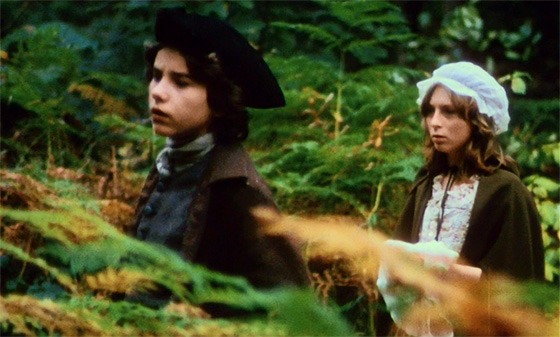
4:40am
Country: United Kingdom
Film: Black Jack (1979)
Principal Transport: Wagons for a Traveling Fair
Trains Spotted: 0
It’s my first film and ought to be the easiest, and already I run into trouble: I’d been planning Alfred Hitchcock’s The Lady Vanishes (1938), until I glanced at the back of my DVD and realized that it doesn’t take place in the U.K. So instead I am taking Black Jack (1979), Ken Loach’s beautiful, naturalistic film set in 18th century Yorkshire. As charming as the film is, essential to its enjoyment is to watch it with the subtitles turned on – the accents are thick and Loach’s commitment to period realism extends not just to natural lighting but occasionally mumbled lines. Still, with that cared for the film is easy to love. The meandering plot follows Tolly, a young draper’s apprentice taken from his home by a murderer named Black Jack, and Belle, a girl whose recovery from a fever has damaged her mind. Multiple blackmail plots ensue; Black Jack learns there’s more ways to make a living than robbing and killing; and Tolly and Belle grow closer, in a relationship which inspired Wes Anderson’s Moonrise Kingdom (2012). My full review is here.
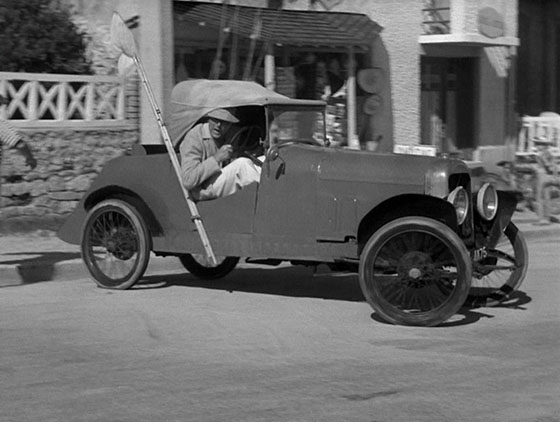
6:30am
Country: France
Film: M. Hulot’s Holiday (1953)
Principal Transport: Jalopy
Trains Spotted: 1
The rules for this game are already proving to be tricky, or perhaps it’s just that it’s early and my mind isn’t exactly sharp right now. (Coffee is now brewing.) I started watching Jacques Tati’s Trafic (1972) – thinking I would hit the highways as I cross France – when I realized I’d be watching two films from the 70’s in a row. Strictly against the rules. So I leaped out and found a different Tati film from an earlier decade, M. Hulot’s Holiday (1953), the quintessential French comedy, and one which opens with Monsieur Hulot’s sputtering jalopy, cars zipping by him. He’s brought to a halt by a dog sleeping in the road, and when he honks his horn, the dog only wags his tail. These are ominous signs for the start of my journey. Sure enough, I am fifty minutes into the film when I realize that I have no toilet paper in the house. None. A costly setback – albeit one unworthy of Tati’s slapstick comedy – I must run to the store. Looking ahead, I intend to journey eastward. Adjacent countries in that direction include Belgium, Germany, Switzerland, and Italy. Originally I was planning a route that would take me through Germany and Poland, but now that M. Hulot has diverted me to the south of France on his holiday, I think I can make a trip through Italy work…
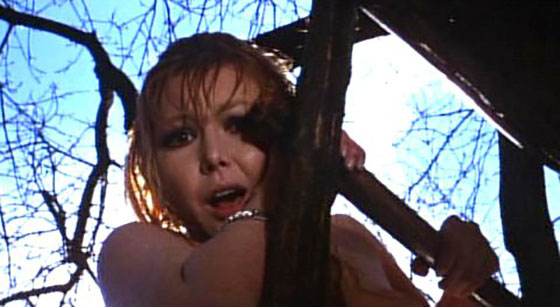
8:30am
Country: Italy
Film: Twitch of the Death Nerve (aka Bay of Blood, 1971)
Principal Transport: A convertible full of doomed teenagers
Trains Spotted: 0
From one waterfront holiday to another. With its bloody killings, Twitch of the Death Nerve (1971) charts a direct course from giallo to the slasher subgenre that would emerge late in the decade. (This wasn’t my first choice – or my second, or third – but the others were Italian Gothics that took place in other countries. Damn Rule #4!) Bava takes what is really a standard-issue giallo plot and enlivens it with humorous transitions (a man biting into an octopus being one of the most jarring), bizarre point-of-view shots, and complex staging for each murder (such as in the strangling of a woman in a wheelchair, or a footchase that ends with a woman’s throat being slashed). It’s schlockier and more crassly exploitative than his earlier horror films like Kill, Baby, Kill (1966), but it’s certainly entertaining: a man opens a door and gets a machete to the face; a couple making love are killed in a double impaling. In the opening sequence, a woman is murdered, and then her murderer is murdered: it’s that kind of movie. Former Bond girl Claudine Auger (Thunderball) plays one of the many schemers.
Now that the coffee’s kicked in, I’m thinking ahead. Rather than going south through the Mediterranean for my next film, I’ll be cutting across into Austria.

10:20am
Country: Austria
Film: The Hands of Orlac (1924)
Principal Transport: Train (which crashes into another train)
Trains Spotted: 2 (crashing into each other)
After concert pianist Paul Orlac (Conrad Veidt, The Cabinet of Dr. Caligari) is critically injured in a train accident, his hands are surgically replaced by those of a recently-executed murderer. This is the worst possible circumstance for both Paul and his wife Yvonne (Alexandra Sorina), who has an overtly erotic attachment to his “beautiful, tender hands.” Upon learning the details of the transplant, and witnessing hallucinations of the smiling killer, Paul declares, “These hands will never be allowed to touch another person!” Without the ability to perform (in both senses of the word), he descends into debt and madness, convincing himself that he is possessed by the spirit of the killer – especially once his hateful father is found dead by the same knife that the executed killer used. The Hands of Orlac (1924), from the director of The Cabinet of Dr. Caligari, was remade a decade later by Karl Freund (The Mummy) as the superb Mad Love (1935) with Peter Lorre. The original is more of a straightforward psychological thriller, its horror elements coming in the form of director Robert Wiene’s use of German Expressionist techniques to portray Orlac’s unraveling. But really it’s all Veidt’s show, dominating the film as a more overtly tormented victim of manipulation than the puppet sleepwalker he played in Caligari.
From here I will head toward the Czech Republic – and, because film is a time machine – Czechoslovakia.

12:25pm
Country: Czechoslovakia
Film: Alice (1988)
Principal Transport: A writing-desk drawer
Trains Spotted: None. Not even a model train, because that wouldn’t involve animal skulls, glass eyes, or sawdust.
But what about those budding young taxidermists? Can’t they have an Alice in Wonderland too? Thankfully we have Czech filmmaker and stop-motion animator Jan Švankmajer to deliver a Wonderland populated by skull-headed animals that bleed sawdust to every brutal injury that Alice dishes out. Here we have flying beds with wings and claws, horse carriages pulled by chickens in red velvet hats, an antique doll that traps Alice inside its body as she stares out through its eye-holes, scuttling cockroaches, a crawling piece of raw meat, and more jars of mysterious preserved things than you can see in a season’s worth of American Horror Story. Alice (1988) provides an interior Wonderland, one contained within four walls of peeling paint, with shelves upon shelves of old and abandoned curiosities, everything musty with neglect. The Caterpillar is a sock decorated with glass eyes and dentures; the White Rabbit has teeth that clack together menacingly. Instead of a rabbit-hole, Alice travels through the drawer of a desk, and as she explores this infinite cabinet of curiosities, she’s almost persuaded to become another stuffed exhibit piece; she even samples a bit of sawdust.
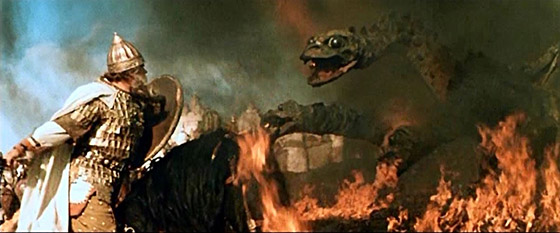
2:25pm
Country: Soviet Union
Film: Ilya Muromets (1956)
Principal Transport: Horseback
Trains Spotted: 0
(Wait, did I just skip the Ukraine? Not exactly. Ilya Muromets was a Soviet film, inclusive of Ukraine, and takes place around Kiev during the time of the Kievan state.)
Ilya Muromets (1956) is another fine slice of Russian folklore from director Aleksandr Ptushko (Ruslan and Ludmila), and, par for the course, features incredible special effects and optical tricks, a seamless blend of location shooting and matte paintings, fine period costumes and grand sets. The title character is a warrior with super strength who rises from his paralytic ennui to defend Kievan Rus from the Mongol horde. He receives his legendary sword from a giant, captures a creature called Nightingale which can blow winds strong enough to bend tree trunks, and battles the three-headed, fire-breathing dragon, Gorynych. Frequently Ilya Muromets plays like a live action Disney animated film – there’s even a scene in which woodland animals help Ilya’s lover work a loom and accompany her as she sings. But it’s also a full-color war epic that was the Soviet Union’s first widescreen film.
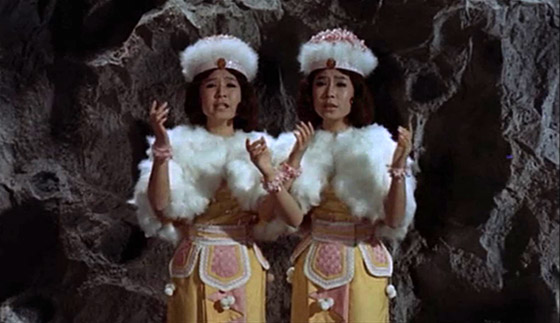
4:20pm
Country: Japan
Film: Mothra vs. Godzilla (1964)
Principal Transport: Japanese freighter
Trains Spotted: Possibly one stationary train glimpsed in the background of a city landscape (uncertain), but otherwise surprisingly train-free for a Godzilla film. I’m gonna go nuts the next time I see a train – mark my words.
I really wanted to go through China next, but I had a dilemma which brought my journey to a temporary halt. I couldn’t find a suitable Chinese film that wasn’t actually from Hong Kong (which I can’t reach directly from Russia). Reluctantly, I decided to skip China altogether and depart Vladivostok through the Sea of Japan, just in time to encounter a green monster egg floating in the water. Japanese fisherman bring it ashore, initiating a battle for control of the egg with the natives of a nearby island both devastated and transformed by atomic radiation. The natives, including a pair of miniature twin girls, worship Mothra, who sleeps in a cave. They warn that the egg will hatch, releasing larvae that will wreak havoc. When Godzilla emerges from the sea, the monster free-for-all begins. Alas, due to the evacuations and wreckage, my passage across the Pacific to the United States is thwarted, and I’m diverted southward on the only boat available. I’m bound for the Philippines next.

6:40pm
Country: Philippines
Film: Raw Force (1982)
Principal Transport: Cruise Ship
Trains Spotted: 0
If I’m going to be accused of cheating at any point during this trip, this is probably the film to single out. For one thing, Raw Force (1982) is really just an American film shot on the cheap in the Philippines, but since the IMDB credits it as a Philippine co-production, I’m squeaking it past Rule #3. The film also stops short of saying it takes place in the Philippines (really, it seems to be hoping we’ll think it’s Hong Kong without outright saying it), so Rule #4 might be dubious as well. But no one has ever really looked that closely at Raw Force, so let’s give it a pass. This is cheap exploitation, the definition of psychotronic. It’s the sort of film that Dirk Diggler would make with his friends in a misguided attempt to go mainstream. Some cruise ship passengers in the South China Sea are waylaid by thugs and find themselves on Warriors’ Island, home to cannibal monks who create blue-skinned zombies in headbands. Serving them is a German with a Hitler mustache who travels to the mainland to kidnap call girls. The central cast is so thrilled to show off their martial arts skills that you can sense them fighting the urge to smile at the camera after every kick. Although it’s clear the filmmakers weren’t taking this seriously – a sleazy party scene with MAD Magazine-style dialogue attempts a Beyond the Valley of the Dolls quality, and falls far short – what they managed to create was a distillation of every grindhouse movie ever made. (Oh, and the Hitler guy gets eaten by piranhas; I should have mentioned that.)
Monsieur Hulot seems like a very long time ago, huh? AND I COULD REALLY USE SOME TRAINS, IT’S BEEN A WHILE.
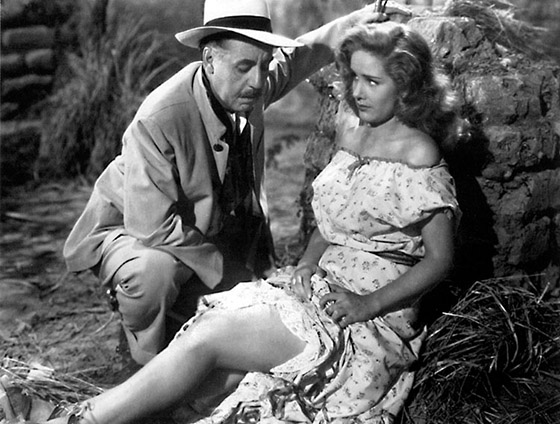
8:30pm
Country: Mexico
Film: Susana (1951)
Principal Transport: Horseback
Trains Spotted: Nothing but Mexican desert.
Departing the Philippines, I’ve finally made the long voyage across the Pacific and docked in Acapulco. From there, I make my way inland to a small village near Mexico City, the setting of Luis Buñuel’s Susana (1951), one of the more offbeat melodramas produced during his Mexican period. If you’re new to Buñuel, it’s probably not the place to start, since in Mexico the famed surrealist tried his hand at mainstream filmmaking while allowing his obsessions and irony to bleed through. On the surface, Susana is a straightforward, albeit wildly sensationalistic portrait of a seductress and her destructive effect on the family that takes her in. But Buñuel opens with Susana in a rat-infested prison during a thunderstorm, pleading for God to set her free: and miraculously the bars come loose, and she crawls out into the mud. A peaceful family sheltered from the storm is confronted with Susana’s face against the window like an apparition in a horror movie. At first she seems like a victim of a tragic upbringing, but it’s not long before she’s shimmying the blouse off her shoulders and strutting amongst the caballeros in the street – and before father and son – bringing doom along with her. In a barn, an egg breaks over her supple legs, and fetishist Buñuel captures the yolk running down them. So Susana can play as a tragedy about the dangers of temptation, as well as a mischievous send-up of moralizing movies, fully on the side of sin. It’s really the latter, giggling like a devil at the hypocrisy of the self-righteous.
Up next: the U.S., and a real chance for trains!
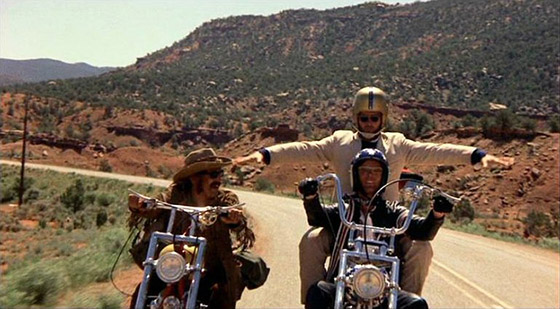
10:18pm
Country: U.S.
Film: Easy Rider (1969)
Principal Transport: Chopper
Trains Spotted: 1! I’ll take it!
Good lord, I am getting seriously tired, having been up since about 4:30 this morning. I’m drinking coffee, and it’s not helping much. But I’m rolling through America now, kicking off with a drug score in Mexico, cashed at Los Angeles, and now I’m traveling cross country to Louisiana. From there I’ll start the route back to Europe, but in the meantime I have good company with Captain America (Peter Fonda) and Billy (Dennis Hopper), as well as Jack Nicholson doing a mean Matthew McConaughey impression (prescient!).
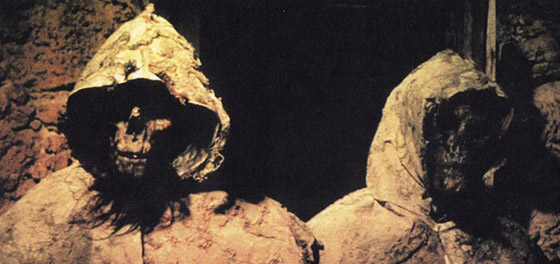
12:00am
Country: Spain
Film: Tombs of the Blind Dead (1971)
Principal Transport: Train!
Trains Spotted: 3
I almost chose a Paul Naschy film for my Spanish entry, but you know what? I wanted a damn train – even if it leads to ruins haunted by the Blind Dead. So now I am picking movies just because they have trains in them – it’s come to this. But Tombs of the Blind Dead (1971) is still an ideal midnight movie. The first in Amando de Ossorio’s “Blind Dead” series, it establishes the concept with simplicity. A sect of Templar Knights sold their soul to the Devil, and after being executed, their eyes pecked out, they now rise from the grave every night, haunting the ruins of an old town and monastery. They’re blind, but make a sound and they’ll corner you – or chase you down on horseback. I feel the “blind” concept is underutilized in the series, which frequently falls back into the zombie subgenre; but what I really like about this first film is the fairy tale aspect: the railway cuts close to the cursed monastery, and the engineer refuses to stop his train on that stretch of tracks. Early in the film, a young woman jumps free, and stranded in that nightmare realm, finds herself prey to the skeletal Templar Knights. The horrific finale brings the concept full circle, and it’s that simplicity of storytelling which I find appealing – like a tale told by a campfire. Plus, how often do you get to see zombies riding horses? The film even answers the question: What happens if you steal one of their undead horses? (Answer: You still lose.) Demerits for needless padding in the middle of the film, and an even more unnecessary rape scene.
How am I doing so far? Well, I just started Jean Rollin’s Requiem for Vampire and then realized, a few minutes into the opening car chase, that it’s another 70’s film and Rule # blah blah blah. I blearily swapped it out for a different Rollin film from the 80’s. I’m on the home stretch, bearing for England.
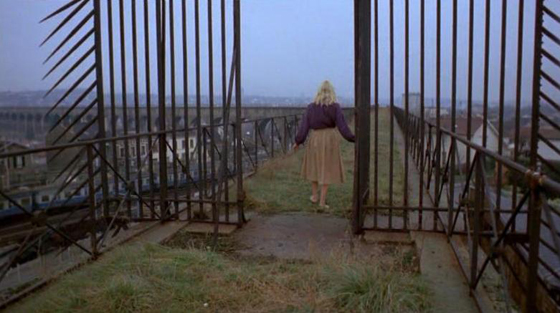
1:55am
Country: France
Film: Night of the Hunted (1980)
Principal Transport: Running through the streets madly with no memory of anything, clad only in a nightgown, which is also kind of how I feel right now.
Trains Spotted: 13? The climax takes place in a rail yard (which I completely forgot about, so it took me by surprise). Unfair; I can’t count this quickly at 3:20 in the morning. Not to mention the multiple camera angles and shifting train placements make an accurate count almost impossible. Someone’s messing with me. I am no longer excited about trains.
With my energy flagging, I can’t do much but point you to my prior review of the film. This is a typical Jean Rollin picture in many ways – slow-moving, at intervals exploitative (sex scenes, violence) and lyrical (the finale, which is one-of-a-kind). A mixed bag, but a must for Rollin fans.
Almost….there….
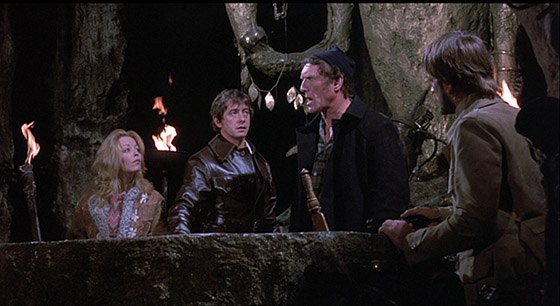
3:37am
Country: United Kingdom
Film: Tower of Evil (1972)
Principal Transport: A fishing vessel called the Sea Ghost
Trains Spotted: Zilch
This film is also known as Horror on Snape Island, which is an awesome title and a great Harry Potter tie-in. It’s also the sort of film that would typically air on cable at 3:37 in the morning, so. A group of attractive young people – and Robin Askwith – land on the titular island, explore an abandoned lighthouse, and are subsequently slaughtered, leaving only one survivor who must be hypnotized to recall the fractured events leading up to the killings. Meanwhile, archaeologists and treasure hunters take an interest in Snape Island as the possible burial site of a wealthy Phoenician chieftain. A cast of characters fit for a Scooby Doo episode descend on the island, and are hunted by a killer as they explore the lighthouse and its secret caves below. This is goofy but straight-faced, and pure exploitation from a period in British cinema when sex and violence were prerequisites with the lightened censorship – and it’s about all my brain can handle at this hour to stay cognizant. Includes dialogue like, “You drive me crazy like that. For Christ’s sake, I’m a man!”
So there you have it, Around the World in 24 Hours with Midnight Only. Thanks to those of you who followed along throughout the day and helped tug me across the finish line. If I would do anything differently, it would be to verify that all the films I might need were readily available. It’s become more clear to me than ever that Netflix and Amazon Instant have very limited selection for foreign films, though increasingly we seem to be dependent on online streaming sources for all our movie-watching needs. (It was physical media – my own library – that saved the day more often than not.) But let’s face it; I will not be doing this again anytime soon. I hear birds chirping out the window as I type this. For now and a while, I’m retiring my inner CinePhileas Fogg.
